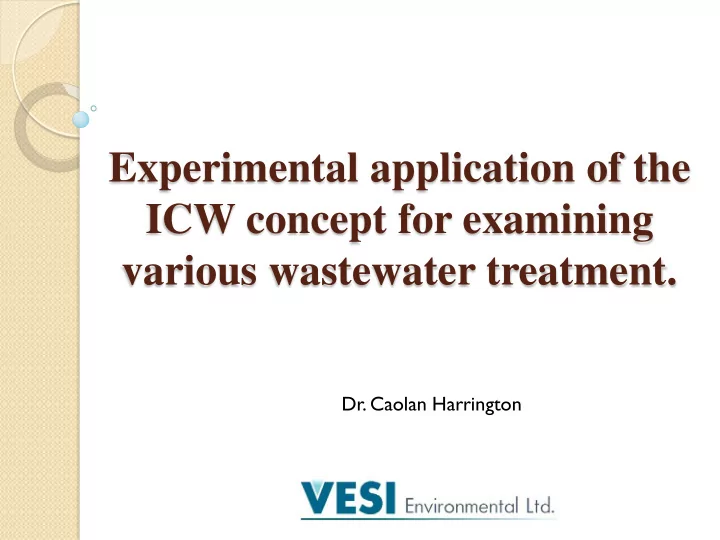

Experimental application of the ICW concept for examining various wastewater treatment. Dr. Caolan Harrington
Meso-scale ICW Experimental platform to test treatment efficacies for water-vectored constituents Complimentary to full-scale ICW systems Experimental investigation of ‘conventionally difficult’ wastewater treatment Practical test bed for preliminary experimental treatment
Meso-scale ICW Versatile ◦ Inherent concepts/design allow for the examination of a wide range of wastewaters Affordable ◦ Using easily sourced materials and equipment keeps construction and maintenance costs to a minimum Replicable ◦ Affordability allows for high-replication of parameters and treatment methods Adjustable ◦ Use of simple mechanics allows for the systems to be high adjustable upon initial setup Accurate ◦ High replicate count rules out erroneous results and errors that can occur: delivering high confidence values
Swine wastewater treatment in Ireland Primary method: Land spreading Other methods: Anaerobic digestion, Composting
Initial development of Meso-scale ICW Creation and operation of a low-cost, linearly scaled ICW system dealing with anaerobically digested (AD) piggery liquid Examination of the treatment of AD liquid using an Integrated Constructed Wetland approach Examine the reliability of such an approach and potential future use of the meso-scale as a test-bed system for experimental examination of various wastewaters
Drivers Water Framework Directive ◦ Directive 2000/60/EC ◦ S.I. 327 of 2012 Nitrates Directive ◦ Directive 91/676/EEC ◦ S.I. 610 of 2010 Septic Tank Infrastructure ◦ EU decision and penalties (2012) Convention on Biodiversity ◦ RAMSAR
Constructed wetlands and Wastewater treatment • World-wide application • Environmentally beneficial vs. • Cost effective • Amenities
Design
Design High replication M ultiple inflows Easily controlled
Design
Design
Operations Hydraulic Effluent Operation Ammonia-N loading recycling Normal 100 mg NH 4 /l 37 m 3 /ha/d no Recycling 100 mg NH 4 /l 37 m 3 /ha/d Yes (100%) High nutrient 200 mg NH 4 /l 37 m 3 /ha/d no loading High flow rate 100 mg NH 4 /l 74 m 3 /ha/d no
Operational timeframe Construction ◦ June 2008 to September 2008 Operation ◦ November 2008 to June 2010 ◦ 18 months fully operational
Operational difficulties Siphon effects Overloading Extreme weather
Ammonia-Nitrogen NH 3 Ammonia NH 3 ◦ Primary basis for dilution of influent 1000.00 Tank 1 Tank 2 Normal High flow Low flow Recycling HNL HFR 100.00 Ammonia-nitrogen (mg/l) 10.00 1.00 Threshold: 0.5 mg/l 0.10 0.01 10/12/2008 10/01/2009 10/02/2009 10/03/2009 10/04/2009 10/05/2009 10/06/2009 10/07/2009 10/08/2009 10/09/2009 10/10/2009 10/11/2009 10/12/2009 10/01/2010 10/02/2010 10/03/2010 10/04/2010 10/05/2010 Date
Hydraulic loading Initial loading @ 100 m 3 /ha/d After 15 weeks reduced to 68 m 3 /ha/d After 17 weeks, reduced to 37 m 3 /ha/d Ammonia (NH 4 ) 1000 120 100 100 80 Cell 1 10 NH 4 (mg/l) 60 Cell 4 1 Storage 40 tank Influent loading 0.1 20 0.01 0 1 3 5 7 9 11 13 15 17 19 21 23 25 27 29 31 33 35 37 39 Sampling week
Molybdate reactive Phosphorus (MRP) MRP Effluent levels ◦ Phosphorus is a key parameter in eutrophication High flow Low flow 10 Molybdate reactive phosphorus (mg/l) Threshold: 1 mg/l 1 Tank 1 0.1 Tank 2 Date Normal Recycling 0.01 HNL HFR 0.001 10/12/2008 10/01/2009 10/02/2009 10/03/2009 10/04/2009 10/05/2009 10/06/2009 10/07/2009 10/08/2009 10/09/2009 10/10/2009 10/11/2009 10/12/2009 10/01/2010 10/02/2010 10/03/2010 10/04/2010 10/05/2010
Exceptional removal with reduced loading rates Normal Recycling HNL HFR Ammonia 99.7% 99.9% 99.8% 99.1% MRP 97.7% 96.0% 94.6% 89.1% Nitrite 95.2% 96.2% 98.4% 83.8% Nitrate 93.0% 92.2% 81.7% 75.7% TON 93.4% 93.1% 92.9% 77.4%
Variability in the systems 1000.000 100.000 Ammonia-N mg/l 10.000 Replicate 1 Replicate 4 Replicate 3 1.000 Replicate 2 0.100 0.010 1 6 11 16 21 26 31 36 41 46 51 56 61 66 Sample Week
Variability in the systems 1000 100 10 Ammonia-N mg/l Series4 1 Series3 Series2 Series1 0.1 0.01 0.001 1 3 5 7 9 11 13 15 17 19 21 23 25 27 29 31 33 35 37 39 41 43 45 47 49 51 53 55 57 59 61 63 65 67 69 Sample Week
Variability in the systems 1000.000 100.000 Ammonia-N mg/l 10.000 Replicate 4 Replicate 3 Replicate 2 1.000 Replicate 1 0.100 0.010 1 3 5 7 9 11 13 15 17 19 21 23 25 27 29 31 33 35 37 39 41 43 45 47 49 51 53 55 57 59 61 63 65 67 69 Sample Week
Variability in the systems 1000.000 100.000 Ammonia-N mg/l 10.000 Replicate 4 Replicate 3 Replicate 2 1.000 Replicate 1 0.100 0.010 1 3 5 7 9 11 13 15 17 19 21 23 25 27 29 31 33 35 37 39 41 43 45 47 49 51 53 55 57 59 61 63 65 67 69 Sample Week
Discussion Linearly-scaled meso-scale systems functioned similarly to other full-scale ICW systems Exceptional nutrient removal rates High replicate count shows reliability in recorded results.
Potential applications Ongoing discussion for development of sludge treatment from municipal WTP Mine wastewater treatment (heavy metal content) Landfill leachate investigation High ammonia content wastewaters
Conclusion Meso-scale approach ◦ Reliable test-bed ◦ Flexible interim experimental scale ◦ Easily maintained ◦ Low cost Land and equipment ◦ Feasible to have high replicate count ◦ Analysis of data ◦ Result comparison Loading rates ◦ Capable of dealing with higher nutrient loadings (>200 mg/l) ◦ High flow showed substantial mass removal, but effluent nutrient levels higher Recycling ◦ Effluent recycling yielded consistently low effluent nutrient levels (ammonia-N) ◦ Year-round performance increase ◦ 4-fold effect; longer retention time, further dilution, extended treatment time, reduced effluent volume
Recommend
More recommend